
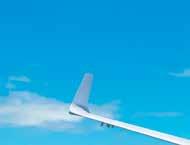





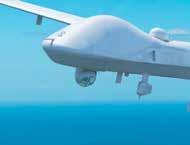
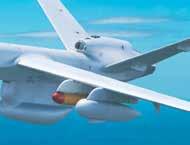
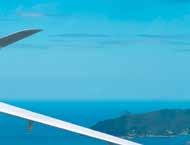
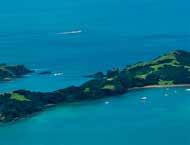
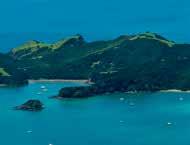
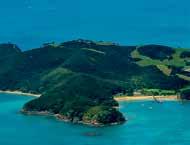
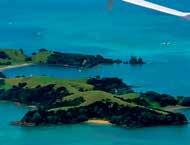




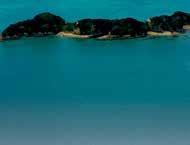










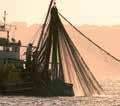













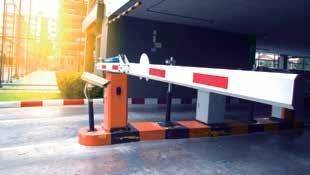


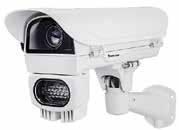
















































Kia ora and welcome to the Summer 2022-23 issue of Line of Defence Magazine ! Another year has flown past putting our collective OODA loop to the test as a new year of uncertainty approaches us at break-neck pace.
In this 26th issue of Line of Defence we continue our new addition to the magazine – the Aerospace section –with excellent insights into Aotearoa’s outer space laws from Dentons Kensington Swan , and a brief on the space insurance market from Rotoiti’s Dr Nicholas Borroz
Nova Systems also profiles its expansion into the space sector, with the company recently engaged by MBIE to undertake a review of high-altitude vehicle launch plans and safety cases.
In Defence, featured contributor Dr Wayne Mapp talks Defence Policy Review and sizes up what capability purchases the post-2023 election government will need to make, while Andy Watts revisits the argument for naval capability adaptability in the form of ‘modularity’.
With LandForces 2022 held recently, correspondent Jennie Vickers profiles some of the Kiwi companies flying the flag at the event and profiles SME and Prime matchmaker BenchOn . And while we’re on the topic of profiles, in this issue we feature an exclusive interview with Babcock’s new Program Director – Strategic Maritime Partnerships Mark Worsfold
Also in Defence, we check in on GA-ASI and the long endurance patrols its MQ-9B SeaGuardian platform has been flaying for Japan’s Coast Guard. Triplex Consulting’s Ross Browne also introduces us to the wondersful volunteer work being conducted throughout the region by Taskforce Kiwi
In Homeland Security we feature insights from the NZ Crowded Places Security Advisory Group’s (CPSAG) Dr Bridgette Sullivan-Taylor and Chris Kumeroa in the wake of last month’s reports of a foiled Auckland terror attack plot. The CPSAG is a voluntary body of security subject matter experts established as a result of an approach by NZ Police to the private security sector to support Protecting Our Crowded Places from Attack: New Zealand’s Strategy.
There’s plenty more great reading in this issue of Line of Defence Magazine, including a piece by Massey University’s Dr Negar Partow in the shared struggles of women in Iran and Afghanistan.
Moving into 2023, we are amping up our digital channels and introducing a range of new online viewing and advertising options, so stay tuned for news on this – and ensure that you have subscribed to Defsec New Zealand’s email updates.
Lastly, seasons greetings from the Line of Defence and Defsec New Zealand, and best wishes for a safe and secure festive season and a great start to 2023!
Nicholas Dynon, Auckland
Hon Dr Wayne Mapp QSO Ross Browne
Chris Kumeroa
CAPT Andrew Watts RNZNR
Dr Bridgette Sullivan-Taylor Nova Systems
Jennie Vickers Mark Worsfold MNZM
Dr Nicholas Borroz General Atomics Aeronautical Hayley Miller Campbell Featherstone Gunes Haksever Ashleigh Ooi Dr Negar Partow Nicholas Dynon
Dr Peter Greener
Prof Rouben Azizian
Dr Bridgette-Sullivan Taylor Dr Reuben Steff
Dr John Battersby Paul Howard Debbie Howarth John Deal
Jennie Vickers Douglas Pauling
Hon Dr Wayne Mapp QSO John Campbell MNZM Ruth Currie DSD Pat Cullen
General Atomics Aeronautical Nova Systems Centre for Defence and Security Studies, Massey University Crowded Places Security Advisory Group Clear Digital
Autumn – March 2023
Main themes: Maritime Domain, Defence Estate, Crime. Copy Deadline: 20 February 2023 Publication: 01 March 2023
Chief Editor:
Publisher:
Nicholas Dynon Craig Flint M: +64 (0)22 366 3691 T: +64 (0) 274 597 621 E: nick@defsec.net.nz E: craig@defsec.net.nz
Postal and delivery address: 27 West Cresent, Te Puru 3575, Thames RD5, New Zealand
Social Media:
www.linkedin.com/company/defsec-media-limited www.facebook.com/defsecmedia/ www.twitter.com/DefsecNZ
Nova Systems Launching Into New Zealand’s Space Sector
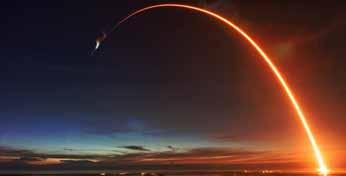
Japan appreciates the game-changing benefits of SeaGuardian. So will New Zealand.
Adam Modd appointed by EPE as Senior Solutions Architect
Calling All Veterans: Taskforce Kiwi
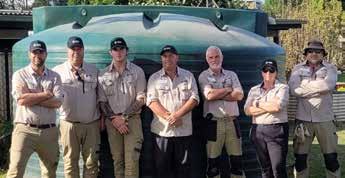
Defence Policy Review: Time stops for no government 16 Modularity: What our partners are doing to build future-focused navies 20 Arms sales of SIPRI Top 100 arms companies grow despite supply chain challenges
LandForces 2022: Does “Where the bloody hell are you” apply to you?
RNZAF takes delivery of first Poseidon aircraft
Strengthening our Ecosystems real and virtuala priority for 2023
New role, same team: An interview with Mark Worsfold
New NZDIA Board of Directors elected
Rotoiti Brief: Structure of the Space Insurance Market
New Zealand teachers access Rocket Lab Mission Control Centre and rocket factory
Review of New Zealand’s outer space laws –further changes to come?
Budget 2023 to provide security in difficult global environment
Planned Auckland terror attack a wake-up call say crowded places security experts
IOM-Microsoft release public dataset on victims and perpetrators of trafficking


Government accepts findings of LynnMall supermarket terror attack review
Opinion: Iranian and Afghani women - united in pain and hope
Defsec Media Limited publishes Line of Defence, FireNZ Magazine and New Zealand Security Magazine premier publications covering industry sectors that help keep Kiwis safe. Find us online www.defsec.net.nz
Copyright: No article or part thereof may be reproduced without prior consent of the publisher. Disclaimer: The information contained in this publication is given in good faith and has been derived from sources believed to be reliable and accurate. However, neither the publishers nor any person involved in the preparation of this publication accept any form of liability whatsoever for its contents including advertisements, editorials, opinions, advice or information or for any consequences from its use.
Nova Systems’ New Zealand arm is now expanding into the country’s burgeoning space sector, launching into the multi-billion-dollar industry as the growing global company continues to support the delivery of key aerospace projects.
The company has recently been engaged by the New Zealand Space Agency, part of the New Zealand Government’s Ministry of Business, Innovation and Employment, to undertake a review of high-altitude vehicle launch plans and safety cases.
Director of Aerospace (NZ) Peter Johnson said expanding into space was a natural fit for the Nova Systems.
“Our New Zealand team is really excited to be launching into space given the huge potential in this growing industry,” Johnson said.
Nova Systems NZ Director Aerospace Peter Johnson.

“Space is opening up a world of possibilities that weren’t available just a couple of years ago, so it’s really great to see a number of private companies doing some amazing things.”
Following the New Zealand Government’s support for a space agency, Johnson said the sector was ripe with potential.
“The cost of launching is coming down dramatically which is opening up possibilities in everything from communications to research,” he said.
“For example, a university can now design, construct and have a small cube-satellite launched. Space is becoming more accessible, so why wouldn’t lots of companies in New Zealand and Nova Systems want to be part of that?

“Nova Systems New Zealand employs experienced aerospace engineers with an understanding of regulatory approvals and the technical analysis required to conduct this exciting work.”
In addition to expanding into the space industry, Nova Systems continues to support New Zealand’s Ministry of Defence in its delivery of the new, once-in-a-generation, Boeing P-8A Poseidon maritime patrol aircraft.
“We’re managing the trials and development, which is essentially making sure the Air Force is ready to receive the aircraft as soon as possible, but also making sure the systems that wrap around the aircraft are going to work as required.”
In addition, Nova Systems has been supporting the Future Maritime Helicopter Project.
Johnson said aerospace was crucial to defence but also served to support everything from disaster relief, search and rescue and humanitarian efforts, as highlighted during the COVID-19 pandemic.
“Using the pandemic as an example, the NZDF helped deploy COVID vaccinations and PPE via air to many of our neighbouring Pacific countries and that’s a crucial part of the NZDF’s core business today,” he said.
“In search and rescue, it shows we’re supporting our Pacific neighbours in whatever way they
need, and we will be there should they need aid or help following a natural disaster.”
As technology continues to evolve and change, Johnson said aerospace continues to flourish and offer new opportunities for growth. “Aerospace has changed a lot in the past five years,” he said.
“The industry is figuring out new and better ways of using autonomous drones to carry out work in dangerous and remote areas and is developing innovative means to provide essential needs, such as aerial imagery.
“There is a clear shift towards electric aircraft and sustainable air travel as the sector strives to decarbonise to achieve New Zealand’s target of net zero greenhouse gas emissions by 2050.
“All this new technology needs the right systems around it, be that infrastructure, data or information and communication systems – and Nova Systems can support this work.”
Johnson said Nova Systems has a competitive edge as the company draws from its global workforce across strategically located offices in New Zealand, Australia, the UK, Norway and Singapore.
“We have access to around 1000 talented people around the world,” Johnson said.
“I was on a conference call with a New Zealand client recently and Nova Systems experts in their fields from Australia, Norway and New Zealand were all putting in their expertise to provide the client a global perspective – a huge bonus.”
Nova Systems has supported defence and government in New Zealand since 2008.
Now with offices in Wellington and Auckland, Nova Systems continues to expand its workforce and client base.
“The sky is not the limit when it comes to air domain and aerospace, and Nova Systems is focused on continuing to grow and expand – so watch this space,” Johnson said.

New maritime patrols from Hachinohe show the endurance, flexibility and value of medium-altitude, long-endurance, remotely piloted aircraft in the Western Pacific.
Serious security challenges call for serious responses. This is true all over the world, but seldom more urgently than in the Western Pacific.
The good news is that responsible governments there are leading the way with new approaches and systems to preserve their edge in intelligence, surveillance, and reconnaissance. As they redefine these practices, they show what’s possible for other nations in the neighborhood or farther afield.
New Zealand faces a number of challenges in securing its vast exclusive economic zone and broader area of interest, whilst achieving a challenging array of defence roles. Recent initiatives undertaken by Japan could prove highly relevant as the New Zealand government assesses its options.
Japan has begun regular long distance/long endurance patrols with the new MQ-9B SeaGuardian, a medium-altitude, long-endurance unmanned aircraft built by General Atomics Aeronautical Systems, Inc.

The Japan Coast Guard operates the aircraft from Japan Maritime Self Defense Force Air Station Hachinohe and patrols broad sections of the Sea of Japan. This includes the rich fishing grounds
of the Yamato Bank and elsewhere, including over the Pacific waters to the east of the islands. Japan Coast Guard officials share their insights about these missions with officials of the Self Defense Force.
These operations unlock a huge trove of insights about what’s taking place around the home and distant islands, applicable for any number of important uses. Tokyo can monitor and deter illegal fishing by foreign vessels. It can detect smuggling. It can preserve
high-quality awareness about what’s taking place in areas of interest, and it can respond quickly if a vessel is in distress.
A growing number of other nations also are operating the SeaGuardian or its sibling, the MQ9B SkyGuardian, to gain access to these kinds of insights and mission options.
What sets these systems apart? They can do things no other aircraft can. For example, they can fly cost effectively for 24 hours or more in a
single mission, depending on their configuration, much longer than any human-crewed aircraft could. That means coast guard officials or other users have the option to sweep large sections of ocean over a patrol and, if they spot something – like a vessel in distress – to stay with it and observe virtually nonstop. Working in teams with multiple aircraft relieving each other, SeaGuardian means never having to take eyes off a subject of interest. And the aircraft has been proven on operations in some of the most challenging weather conditions that might be expected.
Because of its linage tracing back through the MQ-1 Predator and MQ-9A Reaper aircraft, the MQ9B is equally effective for overland missions ranging from forestry and key infrastructure monitoring through to search and rescue, humanitarian assistance and disaster relief, and communications relay roles.
The aircraft are flown via satellite from a ground station – in Japan’s case, also from Hachinohe. That means no difficult remote or overseas deployments for the human crew to work from a forward operating base.
It also means that the human pilots can work in regular shifts, with fresh crews taking over in ways that can’t work with conventional surveillance aircraft.
An electro-optical infrared sensor provides full-motion video to operators and any other users who need it. A synthetic aperture radar lets the aircraft see through clouds, haze or smoke. The SeaGuardian aircraft can operate alone or in teams, and always in concert with other units, including human-crewed aircraft and ships.
One valuable example is the virtuous relationship between MQ9B and human-occupied maritime patrol aircraft such as the P-8 Poseidon, the P-3 Orion or others. The MQ-9B is much cheaper to operate than those aircraft, which means that navies can save the cost and wear they might have used flying the larger, older-model systems –then, when the time comes, expand the sensing, endurance and versatility of the human-crewed aircraft. An MQ-9B might spend several patrols autonomously searching for a hostile
submarine, then enable a humancrewed anti-submarine aircraft to head directly for it.
Another example of powerful teaming is the pairing of MQ9B with satellites. Space sensing improves all the time and it’s an irreplaceable part of the defence and security world but it’s also expensive and, in many cases, intermittent. Space surveillance doesn’t provide the persistence that MQ-9B does over, for example, maritime targets, and it can’t image them with the same flexibility and fidelity.
MQ-9B also can carry a number of mission-expanding payloads. The Japan Coast Guard, for example, flies it with a maritime search radar, which lets the aircraft see farther — and in more detail — than it could with only its onboard sensors.
A large and growing array of other payloads offers huge flexibility for other applications. These aircraft can serve as communications nodes, perform specialized sensing, increase their intelligence-gathering and many other capabilities.

This includes greater military roles, from delivering precise ordnance to supporting the hunt for submarines to serving as a precision targeting platform for land or maritime forces. Modern militaries are improving their ability to reach targets with great precision over long distances, including with munitions released by aircraft or surface ships, for example. But to work well, the firing unit must know in detail where its target is, which direction it’s traveling and how fast. This is another critical role for MQ-9B.
Advanced aircraft hardware is only one part of the solution that makes the SeaGuardian and SkyGuardian revolutionary. The amount of information that the aircraft can collect over many hours of operation could easily become overwhelming to its human operators and the other consumers of the intelligence it produces. This is where the vendor, GA-ASI, also makes the difference: with software.
High levels of automation, artificial intelligence, and machine
learning make SeaGuardian simpler to operate and streamline the exploitation of its reporting. This starts aboard the aircraft itself, where onboard systems can process data and highlight anomalies during a patrol.
For example, SeaGuardian might observe the presence of a vessel using its sensors but not detect it broadcasting on the Automatic Identification System (AIS). Sometimes ships that turn off their AIS signal are attempting to evade detection. SeaGuardian can call this to the attention of human operators. Or the aircraft might detect two vessels in very close proximity on the surface – ships that might be transferring illicit oil or other contraband from one to another. But day or night, in any weather, the crews can’t hide from the SeaGuardian.
For human operators and the coast guard, law enforcement, customs agency and other officials depending on them, software also is a differentiator. GA-ASI’s System for Tasking and Real Time Exploitation – known as STARE – is the gateway from aircraft operations
to the processing, exploitation, and dissemination of intelligence.
STARE doesn’t only receive inputs from SeaGuardian. It also can ingest data from many other sources and create a powerful and yet easy to use common operating picture, one that speeds the work of officials or commanders who need to go from assessing what is taking place to how they’ll respond.
In short, powerful software combined with advanced aircraft hardware delivers an unrivaled tier of multi-domain and multi-mission capability. Risks posed by major revanchist powers in the Asia Pacific region or civil security challenges closer to home call for the best possible intelligence, surveillance and reconnaissance so that responsible governments are equipped with as much knowledge as possible to help them decide how to act.
Japan and other governments are leading the way with MQ-9B SeaGuardian. The vast opportunities presented by SeaGuardian can offer New Zealand cost-effective solutions to some of its most pressing security challenges.

EPE recruits decorated former New Zealand and British Army officer following a career dedicated to the development of domestic and expeditionary EOD capabilities.
Retiring at the rank of Lieutenant Colonel, Adam Modd served in the Armed Forces over a total period of 32 years. He started with an extensive EOD career with the British Army, and in 2007 was requested to be part of a project to develop domestic, expeditionary, and Special Forces CBRNe, IEDD and EOD capabilities for the New Zealand Defence Force.
Adam Commanded E Squadron 1st New Zealand SAS Regiment for over five years, and during his 13 year career in the NZDF represented New Zealand on Five Eye and NATO steering groups, technical working groups and International forums. Adam also deployed overseas supporting Interpol and on Special Forces operations to Afghanistan. He took a two year sabbatical in 2009 / 2010 to work in support of the United States Government on Special Forces programs.
In March 2020 Adam was seconded from the Defence Force to the New Zealand Ministry of Health to assist with the outbreak of COVID, during this time he deployed to the Pacific as the Mission Lead for the New Zealand Medical Assistance Team.
This saw Adam retiring from the military as a Lieutenant Colonel, and consequently taking up the role as Director Emergency Management, Te Whatu Ora –Health New Zealand charged with maintaining the capability and capacity to prevent, protect,
Adam Modd invested as a MNZM by the Governor General for services to the New Zealand Defence Force.

mitigate, respond to and recover from natural, and unnatural threats and crises.
During the span of his military career, Adam undertook a range of leadership, command, operational, scientific research and development, capability development, and capability delivery roles. He has experience on a wide range of operational deployments including Humanitarian Aid & Disaster Relief (HADR), de-mining, Biological Chemical Radiological Nuclear (BCMD), transnational crime, counter-terrorism, counterproliferation, and intelligence.
Adam has served in many areas of conflict, danger and unrest, having deployed on complex multinational, multi-agency operations around the world, as part of Special Forces,
United Nations, OPCW, Interpol. FBI, FVEY & NATO militaries and military intelligence roles. His operational tour experiences include several multiple tours of Northern Ireland, multiple tours of Iraq, Hong Kong, Bosnia, Kosovo, Rwanda, Columbia, Nepal, Cambodia, and numerous tours of Afghanistan.
Adam was awarded the George Medal (GM) by Queen Elizabeth II in 2002 for his gallantry Bomb Disposal operations, and most recently he was recognised with the award of the Distinguished Service Decoration (DSD) in the 2021 Queens Birthday Honours. Adam was also recognised for his counter terrorist work globally with a U.S. Bronze Star, U.S. Army Commendation Medal (ACOM) and three FBI Commendations.
Taskforce Kiwi, a volunteer organisation dedicated to helping communities in the aftermath of natural disasters, is up and running. And if you’re a veteran, or have a background as a firefighter, police officer, or someone with operational, support or emergency management skills, it needs your support.

TF Kiwi’s mission is to utilise the skills and experience of defence and emergency services veterans to help communities get back on their feet, working alongside emergency services agencies and other volunteer organisations.

Taskforce Kiwi
writes Triplex Consulting’s Ross Browne. The skills required for each mission are dependent on the circumstances and the stage the recovery has reached. In the early stages they may include assessing the impact and damage, from the air and on the ground. As recovery progresses the demand is for clearing and disposing of debris, emergency construction, repair of structures, plant operations, logistics support, and management of volunteers. The tasks are interesting and variable, and directly relevant to the existing skills and experience of volunteers.
Are you a defence or emergency services veteran keen to utiliise your skills in the service of communities hit by natural disaster?
might just be for you,
As an organisation dedicated to serving communities, humanitarian principles are at the forefront. These include addressing human suffering wherever it is found especially for vulnerable people, being impartial in the case of an armed conflict or dispute, and remaining autonomous from political, military or other objectives.
A recent deployment saw TF Kiwi providing support across the Tasman in the aftermath of the extreme flooding event in northern New South Wales earlier this year. Several months on, and with

some families still living in tents grappling with chilly weather and sick kids, Taskforce Kiwi volunteers went to the Northern Rivers region of NSW to assist, with seven deployed volunteers providing $18,200 worth of skilled labour over a week. Group leader Richard Adams at the time described the situation as “grim.”
“The floods were six months ago now but could have been last week – the town’s still getting back on its feet,” he said. “The group’s been helping repair homes, remove flood debris, deliver supplies to families,
and clear vegetation in case fires follow the floods. The locals are surprised to see a bunch of Kiwis show up, but are extremely grateful for the help, especially as many feel as though they’ve been forgotten.”
The help is a two-way street, with the group using the trip to learn more about disaster recovery so they can help flood-hit communities back in New Zealand.

TF Kiwi’s leadership have been engaging with NZDF, Veteran’s Affairs and the National Emergency Management Organisation (NEMA) on a no-surprises basis, and to ensure the skills of TF Kiwi volunteers can be effectively utilised in the aftermath of natural disasters at home and abroad.
If you’re interested in getting involved, Taskforce Kiwi is currently recruiting. The full spectrum of skills are needed – from hands on the tools, through to logistics, intelligence and training.
Want to get stuck in? Go to taskforcekiwi.org and fill in the Expression of Interest form. It could start you on the way to an exciting and very rewarding experience with like-minded people.
Major procurements require a steady drumbeat of activity, writes Wayne Mapp, and the post-2023 election government will have purchase decisions to make in relation to the ANZAC and Project Protector fleet replacements.
In October this year, Defence Minister Peeni Henare announced the establishment of an Advisory Panel for the recently established Defence Policy Review, which will be undertaken by the Ministry of Defence.
The Advisory Panel is to be chaired by Sir Brian Roche. The membership includes quite a number of people well versed in defence and foreign policy. The full membership is former Chief of Army, Dave Gawn, Sir Don McKinnon, Professor David Capie, Comptroller of Customs, Christine Stevenson and Pania Tyson Nathan, Chief Executive of NZ Maori Tourism. Sir Brian has substantial experience in Defence Reviews, including chairing the ministerial advisory committee for the 2015 Defence Review.
It is intended that the Defence Policy Review will be completed in 2024, after the upcoming election. Even if there is a change of government, the Advisory Panel may well survive, particularly given its well-balanced membership. By the time of the election they and the Ministry of Defence will have done considerable work which would be of value to any government.
It seems unlikely that the Defence Policy Review will substantially change the direction and orientation of Defence. More likely it will be a refresh of the existing policy framework. Since 2010, defence
reviews, or analogous processes, have taken place on reasonably regular intervals, typically around five years apart. As such they tend to build on the prior work and signal the critical decisions that have to be made within the next five years or so.
Ron Mark, as Minister, made the most significant procurement decisions of the last ten years, providing for the replacement of the C130 Hercules and the P3 Orions, as well as buying 43 Bushmaster to replace the Pinzguaer. These had been well forecast in the 2015 Defence Review as critical capabilities for early replacement.
Since 2010, other Ministers have also made important decisions, including Gerry Brownlee authorising the procurement of HMNZS Aotearoa. More recently the covid crisis has deflected government attention. Minister Peeni Henare has also had to deal with the Ukraine war and the ongoing implications for defence.
The Defence Policy Review will have to take into account the changed circumstances of the international situation, in particular whether New Zealand should increase overall defence spending in line with its international partners. As I have noted in previous articles, even a reasonable boost in defence spending would be unlikely to change the basic structure of the Defence Force. Instead such an increase would go toward building resilience

within the existing core capabilities, while providing certainly for the replacement of the key platforms when required.
Although major procurements can be anticipated many years ahead, there is some discretion as to when their replacement will actually be required. Nevertheless, there is ultimately something of a hard barrier since excessive deferral might lead to total failure of critical capabilities.
Major procurements require a steady drumbeat of activity to ensure that capabilities are replaced before the existing platforms become effectively unusable. The likely time for that can be readily forecast. For instance, while the ANZAC frigates can be stretched out to 2035, when they will be nearly 40 years old, going much beyond that would likely lead to their complete failure as credible combat capable units.
The Defence Policy Review will have to focus on sorting out replacement of the ANZAC frigates and the Project Protector fleet, just as the 2015 Defence Review dealt with the replacement of the C130s and the P3 Orions. The replacement of both these naval capabilities will be the largest procurement decisions since the initial acquisition of the ANZAC frigates in 1989, nearly 35 years ago.
In previous articles, I have discussed the options to replace the naval fleet. There are three key capabilities to be considered. These are the combat capable ships, the ANZAC frigates, the patrol fleet, being the two OPVs, and the multi-role sealift ship, HMNZS Canterbury.

In my column in the Spring 2021 edition of Line of Defence, I noted that the Type 31 frigate could be configured as a high or low capability ship and as such could replace both the ANZAC frigates and the OPVs. A fleet of four ships to a common basic design would certainly be an improvement on the current mixed fleet.
There are of course other credible options. The Defence Policy Review should be able to indicate the credible range of choices. The 2015 Refence Review did not go so far as recommending the specific platform choice but instead used exemplars as a guide to the likely platform. Ultimately both exemplars, the C130J and the P8 Poseidon, were actually chosen as the replacement platforms.
The 2024 report back date for the Defence Policy Review suits the procurement timeframe. If the plan is to have new naval capabilities in service around 2035, that leaves eleven years between the report back
date and the in service date. It will only be just enough time.
The decision-making processes of the government mean it will take a minimum of two years from the report back to an actual tender being accepted. That leaves eight or nine years to actually build the replacement ships. It is almost certain that a proven design will be chosen, but any New Zealand order will have to take its place in the production cycle. There will also be the real possibility of substantial work in New Zealand, as was the case for the ANZAC frigates.
The length of the decision cycle reinforces the importance of each government making timely decisions, taking each electoral cycle as a government, even if the subsequent government has the same fundamental composition. Leaving a key decision to the next government can throw out coherent planning and risks capability failure, particularly toward the end of the lifecycle of critical capabilities.
Looking ahead to the likely out of service dates for both the ANZAC and Project Protector fleets means that the next government of 2023 to 2026 will have to make the purchase decisions for the replacement ships. That means more than simply starting the process. The government will need to actually enter into a build contract with a ship builder before the 2026 election.
During the next twelve months, prior to the election, each political party should make clear what their view on appropriate defence policy is. While defence is unlikely to be a top line policy, the major parties especially have enough depth to provide an informed view as to their policy. It is not just an issue for the New Zealand electorate. New Zealand’s partners, in particular Australia, also have an interest in our defence policy given the increasingly challenging international strategic environment.
The Royal
In an over three-decade career in the RNZN, CAPT Andrew Watts RNZNR commanded HMNZ Ships Pukaki, Wellington, Resolution and Te Mana, and served as Director, Capability Development and Programme Director Network Enabled Capability, and Captain, Fleet Personnel & Training. He is a Defence Adviser at KPMG based in Riyadh.
Historically, navies have attempted to acquire combatant ships permanently equipped and trained to defeat threats in all dimensions. The escalating cost of such platforms is now forcing even the largest and most advanced navies to consider alternatives. As discussed in an earlier article (“Modularity and the Shape of New Zealand’s Next Naval Fleet”) published in Issue 22 of Line of Defence, the most promising of these alternatives is ‘capability modularity’. Capability modularity involves the adoption of platforms that can be fitted with removable self-contained capability modules tailored to specific types of operation. The number of platforms acquired can be determined by the number of operations of all types that a given fleet is expected to undertake at any one time, allowing for maintenance and respite. The number and type of capability modules acquired is dependent on the number and type of missions that the fleet is expected to undertake concurrently.
A modular capability concept could achieve the following:
• A force structure that is adaptable at short notice across a much wider range of missions than one based on platforms permanently optimised for a particular function.
• A fleet which as a whole is much more likely to be available for a wide range of missions, including the protection of shipping in the approaches to New Zealand and major international shipping routes in conjunction with our partners.

• The acquisition of platform capability independent of acquisition decisions around mission capability. For instance, modular platforms could be designed to be compatible with advanced capability without the need to commit to buying the modules until the need becomes apparent.
• Standardisation on common platform systems, reducing sustainment costs, simplifying work force training and management by reducing system specialisation, and reducing and simplifying supply chains.
• Future proofing – obsolescence would be addressed by upgrading or replacing capability modules while platforms remained in service. Loss of availability such as that required by the Frigate System Upgrade project would be avoided – together with the cost and schedule risks that are part and parcel of such upgrades.
• Expandability – should future assessments point to a need to provide direct protection to shipping in the approaches to New Zealand (for example), it may be possible to acquire more ASW modules and equip more platforms for the protection of shipping.
• Greater efficiency in work force management. Only those people required for essential common functions would be permanently linked to platforms. Others would be linked to modules and would only be required to go to sea when their modules are required for training and operations. Making this work would require a number of highly complex problems to be solved, but nonetheless it must be considered.
• The early and cost-effective adoption of autonomous vehicle technology. Autonomous capabilities are well adapted to modularity and offer step change
increases in capability, especially in surveillance heavy missions such as ASW, MCM and the building of MDA. Autonomy also reduces work force requirements and the need to put people in dangerous proximity to threats.
There has always been a distinct aversion to early technology adoption amongst New Zealand defence policy makers, and with good reason. Early iterations of new defence technologies tend to be both expensive and risk prone; New Zealand cannot absorb the consequences of technology failure in the way that nations able to fall back on larger force structures can.
It is therefore reasonable for policy makers to ask whether an acquisition strategy based on capability modularity would fall into that high risk category, and to ask what our partners are doing to adopt and thus de-risk the modularity concept.
Firstly, if modularity is a viable alternative to traditional multifunction combatant concepts, why are our main partners still acquiring the latter? The answer to this lies partly in the very long gestation period for almost all types of naval capability.
The Royal Navy’s Type 26 frigate (adopted by Australia and Canada as the basis for their requirements) was conceived in studies initiated in the late 1990s, but the first ship will not enter service until 2026. As capable as these ships undoubtedly are, their basic concept was fixed some time ago – well before modularity as a capability concept had matured to a point where it could be considered for critical front line combatants.

Additionally, acquisition decisions must take into account a variety of considerations, not all of which relate directly to capability concepts.
For example, the Australian government determined that a regular naval shipbuilding drumbeat was essential to defence selfsufficiency. Concurrently, there was an economic need to make up for the loss to the economy of the defunct automotive manufacturing sector. Timing considerations meant that the choice for the future frigate programme was limited to existing designs that could be adapted to Australian needs relatively quickly.
None of the contenders featured modularity as a central design concept, although the Type 26 design selected does incorporate a degree of modularity for ancillary missions, as do most other new and emergent NATO surface combatant classes. Ancillary function modules include medical, special forces support, command and control and autonomous vehicle capability.
The United States has truncated the modular Littoral Combat Ship (LCS) programme and adopted a traditional multifunction combatant

design (FFG(X)) to make up the balance of its “small” surface combatant fleet requirements.
Vice Admiral David H. Lewis, USN (Retired), a former Commander of the US Space and Naval Warfare Systems Command and Deputy Commander of the US Naval Sea Systems Command, commented in a paper in Issue 1, Volume 5 of the US Naval War College Review that:
“The derivative USN FFG(X) war-fighting requirements themselves were developed between 2016 and 2017 to support a planned delivery of the first ship in 2028. Thus, by the time the twenty-ship class is completed in the 2030s, it will be a thirty-twoyear-old design filling a twenty-twoyear-old war-fighting requirement, with little capacity to accept 2040s capabilities or be modernized to address contemporary war-fighting requirements…”
Admiral Lewis’ theme is that the US Navy must adopt what he refers to as open architecture surface warfare design in which mission
payload is de-coupled from platforms in order to remain relevant and effective into the future.
Just as aircraft carriers remain relevant over 50 plus year service lives because they are capable of embarking successive generations of aircraft as they are developed, so surface warships must be designed to embark capability, as opposed to being fitted with it. He cites the Danish STANFLEX concept as an exemplar of what has already been achieved, and LCS as a seemingly lost opportunity.
The decision to truncate the LCS program was not due to the failure of the modularity concept. LCS appears to have fallen short on the value for money front, with the costs of the platforms and capability modules greatly exceeding original estimates. LCS also featured unusually demanding requirements around speed and minimal crew numbers, which together with a compressed development timetable appears to have compromised both performance and availability.

However, the US Naval Sea Systems Command is investing heavily in modularity trials programme. Modular capability will almost certainly be a feature of next generation US fleets.
When it comes to modular concepts for primary as opposed to ancillary capability, the Royal Navy appears to be in the lead. The Type 31 frigate, designed and built to an exceedingly tight budget, will incorporate the containerised Persistent Operational Deployment System (PODS). A large number of potential PODS modules are under development or consideration, including C2, mine countermeasures, precision strike, hydrographic survey, and intriguingly, a “factory” module for the rapid prototyping of autonomous vehicles and equipment repair.
The range of capability potentially offered by PODS will likely exceed that of other current combatant designs, but Type 31 does not feature the primary mission adaptability that was the topic of my
original article and which I believe offers the most promise for the next generation RNZN fleet.
The Royal Navy is also developing the follow on to the Type 31 frigate, the Type 32. The backdrop to the development of Type 32 is provided in the following extract from the Royal Navy’s Maritime Operating Concept, released in September 2022:
“A Protean Maritime Force is one which is fundamentally balanced and possessed of an innate adaptability. Taken further, the Protean Maritime Force is a move away from highly specific platform optimisation towards a force with interdependent and interchangeable system components. It is a force comprised of multiple scalable and flexible systems, organised and orientated for effect not activity. Being Protean by design best positions the Maritime Force to capitalise on disruption – technological, environmental or situational. It increases choice and the utility of the Maritime Force…”
This intriguing statement is expanded on later in the document: “…by breaking the link – and by implication the traditional model –between platforms and capabilities, a System of Systems approach
increases the scope for capability and technology insertion, increasing agility and ultimately contributing to operational advantage. Achieving this is a behavioural challenge. If done half-heartedly or haphazardly, then considerable additional effort is needed later to enable the systems and capabilities to fit into the System of Systems approach..”
“The contemporary Royal Navy is a force designed around platforms – ships, submarines, and aircraft –which have distinct and sometimes singular purposes. This current highly capable platform centric approach is becoming increasingly unaffordable. Taken in combination, a Maritime Task Group may be potent across all sub-domains, but it was not designed with interdependency, modularity, distribution or to be protean in mind from the outset…”
The concepts articulated in the Maritime Operating Concept were foreshadowed in the 2020 Integrated Review, and although a formal requirement for Type 32 has yet to be issued to industry (the project entered the concept phase in October 2022), BAE Systems has produced a concept called the Adaptable Strike
Frigate. The concept is roughly the same size as Type 31 (140m, 6,000 tonnes), with a forward section resembling traditional surface combatants with a medium calibre gun and a vertical launching system for various types of missile.
The after section, however, is dedicated to a wide range of capability modules, including Anti-Submarine Warfare (ASW) systems. The BAE Systems concept thus aligns with the primary mission adaptability aspiration articulated in the Maritime Operating Concept, which I suggest is that which offers the greatest potential for our own future naval capability requirements. To return to the point with which this article began, the fact that the Royal Navy is pursuing capability adaptability and thus modularity to such an ambitious extent should re-assure our own defence policy makers that capability modularity is worth investigating, which is the main point of this article. Leveraging our strong relationship with the Royal Navy to develop a deeper understanding of modularity potential, and exploring possible cooperation on the Type 32 requirement, might pay major dividends.


Sales of arms and military services by the 100 largest defence suppliers reached $592 billion in 2021, a 1.9% increase compared with 2020, according to new data from the Stockholm International Peace Research Institute.
The increase marked the seventh consecutive year of rising global arms sales. However, while the rate of growth in 2020–21 was higher than in 2019–20 (1.1 percent), it was still below the average for the four years leading up to the Covid-19 pandemic (3.7 percent).
Supply chain issues seen in 2021 likely to worsen due to Ukraine war
Many parts of the arms industry were still affected by pandemic-related disruptions in global supply chains in 2021, which included delays in global shipping and shortages of vital components.
“We might have expected even greater growth in arms sales in 2021 without persistent supply chain issues,’ said Dr Lucie Béraud-Sudreau, Director of the Stockholm International Peace Research Institute (SIPRI) Military Expenditure and Arms Production Programme. ‘Both larger and smaller arms companies said that their sales had been affected during the year. Some companies, such as Airbus and General Dynamics, also reported labour shortages.”
Russia’s invasion of Ukraine in February 2022 has added to supply chain challenges for arms companies, not least because Russia is a major supplier of raw materials used in arms production. This could hamper
ongoing efforts in the United States and Europe to strengthen their armed forces and to replenish their stockpiles after sending billions of dollars’ worth of ammunition and other equipment to Ukraine.
“Increasing output takes time,” said Dr Diego Lopes da Silva, SIPRI Senior Researcher. “If supply chain disruptions continue, it may take several years for some of the main arms producers to meet the new demand created by the Ukraine war.”
While reports indicate that Russian companies are increasing production because of the war, they have had difficulty accessing semiconductors. They are also being impacted by war-related sanctions. For example, Almaz-Antey (not included in the Top 100 for 2021 due to lack of data) has stated
that it has not been able to receive payments for some of its arms export deliveries.
The arms sales of the 40 US companies in the listing totalled $299 billion in 2021. North America was the only region to see a drop in arms sales compared with 2020. The 0.8 percent realterms decline was partly due to high inflation in the US economy during 2021. Since 2018, the top five companies in the Top 100 have all been based in the USA.
A recent wave of mergers and acquisitions in the US arms industry continued in 2021. One of the most significant acquisitions was Peraton’s purchase of Perspecta, a government IT specialist, for $7.1 billion.
“We can probably expect to see stronger action from the US government to limit arms industry mergers and acquisitions in the next few years,” said Dr Nan Tian, SIPRI Senior Researcher. “The US Department of Defense has expressed concern that reduced competition in the industry could have knock-on effects on procurement costs and product innovation.”
Europe: Aerospace sales fall, shipbuilding rises
In 2021 there were 27 Top 100 companies headquartered in Europe. Their combined arms sales increased by 4.2 percent compared with 2020, reaching $123 billion.
“Most of the European companies that specialize in military aerospace reported losses for 2021, which they blamed on supply chain disruptions,” said Lorenzo Scarazzato, a researcher with the SIPRI Military Expenditure and Arms Production Programme. “In contrast, European shipbuilders seem to have been less affected by the pandemic fallout and were able to increase their sales in 2021.”
Dassault Aviation Group bucked the trend in the military aerospace sector. The company’s arms sales saw a sharp 59 percent increase to $6.3 billion in 2021, driven by deliveries of a total of 25 Rafale combat aircraft.
Chinese companies drive rapid growth in Asian arms sales
The combined arms sales of the 21 companies in Asia and Oceania included in the Top 100 reached $136 billion in 2021—5.8 percent more than in 2020. The eight Chinese arms companies in the listing had total arms sales of $109 billion, a 6.3 percent increase.
“There has been a wave of consolidation in the Chinese arms industry since the mid 2010s,” said Xiao Liang, a researcher with the SIPRI Military Expenditure and Arms Production Programme. “In 2021 this saw China’s CSSC becoming the biggest military shipbuilder in the world, with arms sales of $11.1 billion, after a merger between two existing companies.”
The combined arms sales of the four South Korean companies in the Top 100 grew by 3.6 percent compared with 2020, reaching $7.2 billion. This was largely due to a 7.6 percent rise in arms sales by Hanwha Aerospace, to $2.6 billion. Hanwha’s arms sales are expected to grow significantly in the coming years, after it signed a major arms deal with Poland in 2022, following the Russian invasion of Ukraine.
Six Russian companies are included in the Top 100 for 2021. Their arms sales totalled $17.8 billion—
an increase of only 0.4 percent over 2020. There were signs that stagnation was widespread across the Russian arms industry.
The five Top 100 companies based in the Middle East generated $15.0 billion in arms sales in 2021. This was a 6.5 percent increase compared with 2020, the fastest pace of growth of all regions represented in the Top 100.
The aggregated arms sales of the four Top 100 companies based in Japan was $9.0 billion, a decline of 1.4 percent compared with 2020.
This is the first year in which a Taiwanese firm appears in the Top 100. NCSIST (ranked 60th), which specialises in missiles and military electronics, recorded arms sales of $2.0 billion in 2021.

Private equity companies are becoming more active in the arms industry, particularly in the USA. This could affect the transparency of arms sales data, due to less stringent financial reporting requirements compared with public companies.
The SIPRI Arms Industry Database was created in 1989. The Top 100 listing includes the 100 companies with the largest arms sales during the year covered and for which SIPRI can access sufficient data. ‘Arms sales’ are defined as sales of military goods and services to military customers domestically and abroad.
Reporting from LandForces 2022, Line of Defence Magazine Correspondent Jennie Vickers highlights the Kiwi companies who made the long-anticipated trip across the ditch to fly the New Zealand flag.
You had to be really determined to go from New Zealand to LandForces in October this year. With fewer flight options out of New Zealand and demand high, flying Qantas was the only option and then only a flight to attend on the last day.
The sense of pent-up demand to meet in person was clearly reflected in the record attendance numbers of 20,000 attendees across three days, 810 participating companies and 39 nations represented, and 128 defence, government, industry, and scientific delegations from 23 countries.
The next LandForces is confirmed for 2024 but before then Avalon
takes place from 28 February to 05 March 2023 and IndoPacific across 7-9 November, so maybe book flights now!
In conversation after the event with organisers AMDA, Chief of the Australian Army, Lieutenant General Simon Stuart AO DSC said:

“It’s been a really energising event. I think we’ve got more participants this year than we’ve ever had before, and I think that speaks volumes to the degree of teamwork and partnership between industry, academia and our Army as we get around solving the problems that our soldiers face on a day-to-day basis.”

New Zealand businesses and supporters of defence in Aotearoa were out in force this year.
Here are some thoughts and reflections on why they were there and why other New Zealand businesses should have been, from just a few of the Kiwi businesses at the event.
The Cratos strategy for LandForces is a great example of kiwi collaboration, with a presence on three different stands: with Teledyne FLIR, with Teal, and with New Zealand. Founder Mick Turner demonstrated his belief in the value of being there by bringing a team of three including: Phil Coyle and Callum Scully, (Chief Drone Pilot and former NZ Army lead RPAS pilot). On returning to New Zealand after the event, Mick Turner commented: “Land Forces 2022 was a great event for us (supported by our primary long-term partners at Teledyne FLIR) which enabled us to showcase new technologies in Integrated Solutions, Uncrewed Systems and Detection. It was also exciting to introduce Teal Drones and the Golden Eagle to Australia and New Zealand. This was the first time this emerging, industry leading UAS has been shown in the region. Look out for us, we are following up with some exciting Teledyne FLIR developments at Avalon in 2023.” https://www.cratos.com.au.
Our old friend Tim Watson of Chiron Global Tech, had his team demonstrating their new X-1 Training Armour on the DangerSolutions Stand. Their demo included the firing of UTM training munitions safely at point blank range into the suit!
“The consistent and regular attendance by Chiron at events such as LandForces has made an
important difference to us,” said Tim Watson. “We are remembered and recognised and each new conversation with a potential customer leverages from where we left off pre-Covid-19, with no need for a return to square one. This enabled us to substantially increase the number of qualified customer interactions we could squeeze into three busy days.”
Shark Seating Shark exhibited for a second time in a row at LandForces this year, making this their fourth time exhibiting to ADOD in Australia (Indo Pacific accounting for the other two events).
“This show was special because now we are widely known and our product is in use by many,” explained Paul Zwaan, Founder and CEO. “So our further discussions are happening in an environment of trust and confidence, resulting in some significant projects currently in the RFT phase.”
Customers were impressed by the modular approach we have taken, which allows maximum versatility, 26 modules, each with their own NATO Stock Number, can be combined as desired to make a plethora of seat configurations. This flexibility is popular as demonstrated by the number of unique
combinations which have been used on hundreds of defence boats in the Indo Pacific region, during our 10 years in business.
“Shark is trying to introduce standardisation into the way seats of this kind are fitted, and has utilised a universally accepted track system that makes it possible for even our competitors to fit shark mounting tracks and vice-versa,” he said. “It is what is best for the end user that drives us forward, and standardisation helps with that”.
Aliesha Staples, CEO of StaplesVR which creates “AR/VR training that improves and saves lives” explained that being able to, “talk directly to customers at Landforces and show our products firsthand has been a huge benefit of attending the conference. Also, the opportunity to network with like-minded suppliers and potential customers was enormously valuable.”

https://www.staplesvr.com.
It was hard to get onto the ADA stand such was the excitement and buzz around it. The range of innovation ranging from equipment delivery through to the clothing items themselves were drawing a crowd.
“Land Forces 2022 was not only a great opportunity to showcase a cascade of uniforms, body armour and load carriage innovations,” explained ADA CEO Chris Dixon, “but also how ADA is revolutionising the experience with advanced technological integration.”

“The individuals who serve our communities and country deserve the best apparel and the best experience. Sharing with the public our vision of how we protect those who protect us we hope will foster a deeper sense of appreciation.” Mr Dixon said.
“ADA’s successful operation comes down to many factors, but our constant commitment to combining leading textiles and new technologies to solve design problems, is key. At the end of the day, we exist to protect those who protect us, and to ensure
they have access to high-tech apparel systems that are enhanced by seamless fitting solutions and processes.
“The future of apparel delivery is about simplicity, circularity and connectedness,” he explained. “We are delighted to have secured the entire clothing contract to the New Zealand Defence Force, having gone live with the contract in February. This has led to the creation of ADA New Zealand, allowing us to work with local New Zealand manufacturers, as well as build a brand-new facility in Palmerston North,” said Mr Dixon.
A quick shout out to other companies at LandForces who are Kiwis and/or friends of New Zealand
and which will be featured next year. It was good to reconnect with Kongsberg, L3Harris, DXC, Thales, Lockheed Martin, Rheinmetall, BAE Systems and many more.
It was also a great pleasure to catch up with a number of Australian Veterans who we have connected with in the past. Ranging from young blokes like Neil Curtis of DXC through to Keith Payne who is the last living Australian recipient of the original ‘Imperial’ Victoria Cross. Next year look out for features about Veterans career paths in 2023.

And last but not least…
SMEs who have tried to get face time during the year with senior defence people to demonstrate amazing innovations and solutions, will tell you it is virtually impossible.
So Patrick Gottstein, Manager of Go Logistics Group is chuffed with this photo from LandForces, showing Go taking the opportunity to introduce the Chief of the Australian Army, Lieutenant General Simon Stuart AO DSC, to their way of managing logistics.
Go Logistics Group were first time attendees and exhibitors at LandForces. Patrick shared some of the many reasons (apart from time with the Chief of Army) why they were so delighted with their LandForces experience:

“The old Qantas ad said “where the bloody hell are you,” and this speaks volumes as to why NZ SMEs who need to qualify an opportunity or follow up, need to attend in person either as an exhibitor or as a visitor. NZ government has dedicated teams in country including an excellent Defence Attaché, so there are really no excuses not to make the journey.”
There is time to get planning for Avalon and IndoPacific as soon as the holidays are over!
Minister of Defence Peeni Henare marked the arrival on 13 December of the first of New Zealand’s P-8A Poseidon aircraft at RNZAF Base Ohakea, the first of four new P-8A Poseidon aircraft.
Having rolled out of the paint factory in July, and getting airborne for the first time in August ahead of a systems fitout, the first the RNZAF’s new P-8As has landed in Aotearoa.
“The P-8s will replace the Orions, conducting maritime surveillance, resource protection, natural disaster support and search and rescue operations as we work alongside our Pacific partners to support the security and stability of the region,” said Minister Henare.
“With the ability to travel faster and with greater reliability than the existing aircraft the P-8A will be a key capability to support national and international disaster responses as a result of climate change.
“To help move into a new era of maritime surveillance and in order to ensure we focus our efforts on the training and maintenance required of the new aircrafts we are reprioritising our workforce to allow for the safe transition to the four P-8A Poseidons.
“An important part of this launch is seeing the mahi so far on a purpose built facility to house the new aircrafts. Built right here at Base Ohakea it measures 180m long, 26m high and 80m wide with an average of 250 workers onsite each day,” Peeni Henare said. The official welcome ceremony for the first P-8A was
attended by 450 guests including Ambassadors, local community members, and Defence personnel.
“New Zealand’s first P-8A aircraft marks a major milestone in the decisions taken since 2018 to replace those Defence Force capabilities that have served the country’s interests, and those of our friends and neighbours, for more than three generations,” Peeni Henare.
“To the current, and future generations of Royal New Zealand Air Force personnel who will operate the P-8A, thank you for your commitment to continuing this record of service,” Peeni Henare said.
The Strategic Defence Policy Statement 2018, launched in July 2018, provided a basis for the P-8A to be considered against the Government’s priorities and policy settings. The Statement emphasised the importance of New Zealand’s maritime domain, and that maritime security is fundamental to national security.
In July 2018 the Government approved acquisition of four Boeing P-8A Poseidon maritime patrol aircraft to replace the RNZAF’s six aging P-3K2 Orion aircraft. Of the available options, the P-8A Poseidon was assessed to be the lowest cost and lowest risk option.
The remaining aircraft are scheduled to arrive by mid2023.
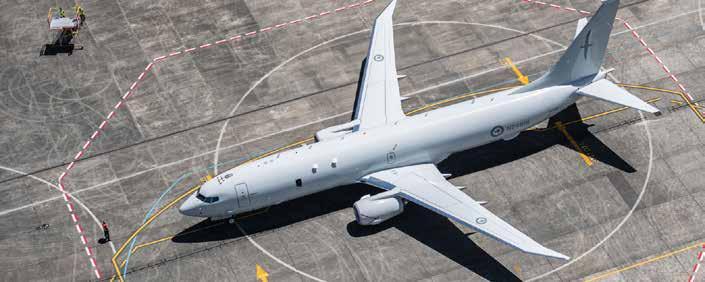
Line of Defence Magazine correspondent Jennie Vickers continues her coverage of LandForces 2022 with a profile of BenchOn and the ecosystem approach that drives their tech development and strategy.
Advocating for New Zealand businesses into the Defence sectors in both New Zealand and Australia, is a habit I am hopefully never going to give up.
During my four years as CEO of the Defence Industry Association (up to June 2020) I had the opportunity to create an ecosystem into which SMEs from New Zealand and Australia could get into the orbit of defence projects and buyers from both countries.
We were in a unique and privileged position to do this, so that membership of the association was not seen as a pre-requisite of joining these conversations. Value in a community comes initially from connections, not revenue. Everyone gains when the widest possible ecosystem is created to enable organisations to find each other and then to collaborate.
I became a fan of BenchOn when they were introduced to New
Zealand by Hanwha back in 2019. Hanwha was a new entrant into the New Zealand market at a time when the Broader Outcomes principles were in their early days. Hanwha realised that to be seen as serious about New Zealand they needed to build a viable supply chain and build the right local relationships.
BenchOn started life as an AI driven platform established to support a sharing economy ethos and meet a gap in the market for short term staff resource demand and supply matching. The ecosystem approach drives their tech development and strategy.

Along the way the team realised that their technology had the ability to solve a related but different problem: the matching of SMEs with capacity or capability into Prime supply chains quickly and efficiently. The key difference that distinguished BenchOn from the existing platform being used in Australia (and used in New Zealand 15 years ago) is the use of AI to assist in efficient matching of capability and need.
Their tech platform development plans nicely match the industry ecosystem philosophy.
Fast forward to 2022 and with the support and encouragement of AMDA (the organisers of LandForces 2022) BenchOn launched a big new initiative at
the event. The Meet the Primes Programme enabled over 350 SMEs to meet with 17 Primes, and 164 meetings were facilitated. BenchOn is proud that they can already point to the signing of approximately five contracts as a result of this meet and match event.


The good news is that BenchOn is already committed to bringing its ecosystem to both Avalon in March 2023 and IndoPacific in November 2023.
Previous Forum attendees should remember Michael McLean from Goal Group in Australia. Mick is a good friend of New Zealand and he reminded us at LandForces about the Defence Ready Seminar Series, which is a joint initiative between Hunter Defence, Office of Defence Industry Support (ODIS), Goal Group, and Australian Industry & Defence Network NSW.
Every opportunity I get, I take to remind Australians that New Zealand is part of sovereign capability and under free trade counts as local content. We all need to take every opportunity to talk about this local content status and to get Kiwis into, for example, this Defence Ready programme. In the meantime, setting up an entity in Australia is not that hard, so that route may be an option too.
Back to BenchOn. Companies that move into a BenchOn ecosystem connecting to Primes do better and faster if they have done the groundwork via a programme like Defence Ready.
“BenchOn has saved us time, effort and cost in resourcing our programs and has also made it easier for our suppliers to pursue opportunities with us,” said the Director Service Delivery from
Jacobs Australia says. “Our aim has always been to create a mutually beneficial supplier relationship where selection for subcontractor roles is based on merit and supports a Best for Client outcome. This portal has definitely achieved that.”
So, wrapping up December seems like a good time for a New Year’s resolution on the part of government and industry to find a way to ensure that New Zealand businesses are welcomed into the Defence Ready Training Programmes and that Primes use the best available technology to build strong supplier relationships between New Zealand and Australia.
BenchOn has shared some of the changes it is initiating for the Meet the Primes Programmes at Avalon and IndoPacific in order to give New Zealand companies advance notice on what to prep for. The Primes are keen. They will share their capability needs and NZ SMEs will have a chance again at these events to pitch their matching solutions, both in person and virtually.
Why the bloody hell would we not want to be there? But hopefully we can go by Air New Zealand this time!
In this exclusive interview, chief editor Nicholas Dynon talks with Mark Worsfold MNZM about his RNZN career highlights, the Maritime Enterprise Sustainment Team, and the priorities for his new role.
Mark Worsfold has joined Babcock Australasia as Program Director –Strategic Maritime Partnerships last week after 35 years’ service with the Royal New Zealand Navy, his most recent role as Logistics Commander (Maritime).
Babcock provides asset management services including engineering, project management, production and operational support to the entire RNZN fleet, from the frigates through to small craft. In his new role with Babcock, Mark will be responsible for the safe delivery of New Zealand’s Maritime Fleet Sustainment Services (MFSS) program.
“We are thrilled to welcome Mark to the Babcock team after working closely with him over many years through Babcock’s partnership with the RNZN,” said David Ruff, CEO Babcock Australasia. “His detailed knowledge of the New Zealand sustainment enterprise will enhance operational effectiveness and leadership of the team.
“Mark will play a fundamental role in maintaining Babcock’s position as the premier warship sustainer in the region. He will leverage Babcock regional and global capability to bring best practice and value to the New Zealand program,” he said.
Mark will also continue leading the Maritime Enterprise Sustainment Team (MEST) – the collaborative partnership that supports the RNZN Fleet. The
partnership has been awarded two international five-star best practice awards – the first in 2021 for the way it navigated through the first wave of the COVID-19 pandemic, and the second in 2022 for collaborative negotiations.
Interviewed in the September 2022 issue of Navy Today, Worsfold, who hails from Auckland and joined the RNZN on 27 January 1987, noted that his best deployment was to the Persian Gulf on Operation Enduring Freedom (2004). The first ship he was posted to was HMNZS Southland.

He was made a Member of the New Zealand Order of Merit in 2016 for services to the NZDF.
ND: You forged a strong relationship with Babcock in your role as Logistics Commander (Maritime). What’s it like to now be on the supplier side of the partnership?
MW: The transition’s gone surprisingly well. I guess that’s down to the fact that the partnership’s always been one team: a common leadership team, a common purpose, and a common outputs focus on making sure the navy has the ships it needs when it needs them. It’s a different side of the contract, a different side of the partnership, but still the same team with the same purpose and the outcomes. As transitions go, it’s probably been the simplest.
I was talking to someone in the Navy last week and they said I had transitioned reasonably quickly, but really I didn’t have much to transition. I’ve had to take the uniform off and I now have to figure out what to wear and plan my day a bit more carefully, but the overall objective, purpose, and reason to come to work hasn’t changed.
ND: The Maritime Enterprise Sustainment Team (MEST) is an award winning partnership. What have been the ingredients for its success, and what can Defence and Industry organisations learn from its success?

MW: Many ingredients have come together. Initially people thought that it was just a simple case of the right personalities, but it’s way beyond personalities. In a lot of partnerships and contracts one party in the partnership is regarded as the customer, but in the MEST’s
case the common customer is the Navy. Myself and the now logistics commander are partners and our customer is the Navy. And as long as all of our teams understand that there’s no ‘us’ and ‘them’ in the MEST; we can bring our purpose together and people understand that we’re here to do things for the Navy.
So it doesn’t matter what’s on your lapel or your chest, or whether it’s Navy or Defence or Babcock, when you’re part of the MEST you’re part of the team that actually looks after the Navy, and a lot of people resonate with that. When one of our ships sails past, for example, we see our people lining the windows to have a look at it and you can hear them say “I’m going to go home tonight and say that I was a part of that.” It’s really cool to see that.
The other thing that really works here is that the team works together because they sit together, they have cups of tea together, and they have meetings together. All of our
documents and processes are cosigned. If it’s a high level document, myself and the logistics commander (or other members of the leadership) will sign it – there’s always both sides of the partnership signing the document. In every message we send out to tell the workforce what’s going on there’s the names of both of us at the bottom of the message.
Previous iterations of this contract have been very much decider-provider transaction based. Nowadays, we articulate what we’d like to achieve and how can we best do that, and we build a package to deliver that, and then we measure it against resourcing and time, and then adjust it together. There are no surprises.
It’s also important to note that the MEST isn’t just us, it’s part of what I call the wider village. There are some 600 other companies in New Zealand that contribute to the sustainment of the ships. We’re working in different ways
of formalising the village concept through the NZDIA, through our partners who have premises on the base, and through all the other people who help us look after the ships. The village concept come because it takes a village to sustain a ship and everyone needs to know where they are in the village.
ND: You start your new role in the enviable position of already having a deep understanding of the landscape. Where are the areas of new learning for you?
MW: Even if you know what you’re doing, every day is a learning opportunity. Every day you should learn something new.
I did 35 years in the Navy, around a quarter of which was in Auckland, a quarter in Wellington, a quarter overseas, and a quarter at sea. I lived in nine cities, did attachments to three other navies, and lived in four countries. My entire career has been about learning something new

and adapting to processes, so I’m accustomed to reading myself into a new role.
One of the differences here is that when I was in the Navy, home base was in Devonport and headquarters was in Wellington. I’m now part of an organisation with premises here in Auckland, Sydney, Adelaide, Melbourne, Canberra and Perth and that’s just part of the Australian region within what is a global company. So I’m learning to understand the layers and the levers and the golden thread of business, where I can find help and where I can get support. Thankfully. all the help and support has been leant in to me and I haven’t had to go too far to find it.
We look after the Navy fleet here but across the region we’re looking after another 37 ships in Australia, so I’m not alone. But the learning is around finding where all those other people are and what they’re doing, and then around how we can bring their learning into here and how we can share our really good process
within the region as well. It’s going to be a fascinating journey and I’m really looking forward to it.
ND: What are your priorities as Program Director – Strategic Maritime Partnerships?
MW: My absolute priority is the safe delivery of our work. Keeping our people safe while delivering what’s required of them is a bit of a personal mantra. You’ve got to “make safe, start safe, and keep safe”.
One of the Babcock mottos is “home safe every day” and that’s something we need to make sure of. We work in a complex environment in an industrial zone on ships that move, with heavy machinery and large bits of kits. An absolute priority is to keep people safe while we do that.
The second priority is to support the Navy achieve what they need to do. We are here to help the Navy be the best navy it can be. And as long as we can keep this partnership in the collegiate fashion that it is in at
the moment – while understanding that what we’re trying to keep safe is paramount – we will succeed in this.
ND: You’ve moved on from the Navy after a 35 year career. What are the key highlights?
MW: The flippant answer is that any day at sea was a blessing! An absolute highlight is all the times I spent at sea.
I spent time as a naval attaché in Washington DC with my family and that was a really good learning experience. I did an attachment with the Australian Navy and attachments with the Royal Navy. All of these experiences helped to round me.
But I’m a bit of a people person. A lot of people think that my best job ever was as Logistics Commander (Maritime), but if I had to pick one job it would have to be when I was running HR for the Navy.
The Navy and Babcock are people businesses. If you don’t understand
people and you don’t want to engage with people then you’re in the wrong business. Sailors are at the heart of the Navy, so leading that people function was a genuine honour.

But every job I’m in is the best job… and there are too many highlights. I wouldn’t have stayed for 35 years if I wasn’t enjoying what I was doing.
ND: Which skills and experiences do you see as the most portable into the private sector?
MW: My last three jobs as a Captain in the Navy was running engineering, running strategy, and running the HR/people function. Those are key skills that would be relevant anywhere. But I learned along the way that no matter what job you’re in, as long as you know what you’re trying to achieve, you know what resources you actually have, and you understand the barriers to success, then once you’ve read into that role you can actually
run it. I’m taking this philosophy into my new role.
My transition was relatively easy because I understood what was important to me. I like people, I like engineering, and I like the Navy. Coming to work in an organisation that is basically the largest maritime engineering entity in the country, and part of a global company that understand people, resonated with me and aligned with my principles. What gets me up each morning is making sure that my principles aren’t challenged and that I’m achieving something.
Babcock offers that, and I’m sure that everyone who wants to transition will find exactly the same thing if they understand what it is: don’t leap to the first thing but leap to the thing that’s important to you. I wish anyone going through that thought process good luck, and to those who have transitioned I hope that they’ve got what they wanted and that they continue to enjoy what they do.
As a result of elections conducted at the 2022 Annual General Meeting (AGM) held online on the afternoon of the 8th of December, the NZDIA has announced the election of two new elected members to its Board of Directors. Briar Riddell from Beca and John Campbell from Strategic Sourcing Consultancy will officially take their positions early in 2023.
“Thank you to all those who put themselves forward as nominees,” wrote NZDIA CEO Ian Harman in announcing the election results. “It was encouraging to see nominees from a wide cross section of the NZDIA Membership and the voting was very close.”
The AGM also saw the approval of the Minutes from the 2021 AGM and the Financial report of the year 2021-2022 was also approved and accepted.
Briar Riddell is Principal Legal Counsel for Beca’s Defence & National Security business group (both in NZ and Australia), as well as for the company’s Digital practice.
Briar has been supporting Beca’s projects in the Defence sector more than 14 years, and has recently been appointed as a director on the

board of Beca Applied Technologies Ltd. She also currently serves as a director for Beca Projects NZ Ltd, and on the governance boards of some of the company’s digital enterprises.

Last year, Briar was part of the first cohort of KiwiNet’s Women in Leadership Development programme, aimed at bringing more women in STEM through to governance roles, which included a board observation role and ongoing mentoring.
Her legal background is in general commercial, technology and intellectual property, and a career highlight to date has been contributing to the legal and insurance aspects of the Defence Estate & Infrastructure Alliance.
In her election pitch, Briar stated that she would be grateful for the opportunity to contribute to the governance of NZDIA, “and the ongoing great work our association does to advocate for industry in the Defence sector, and to continue to improve commercial access and procurement conditions for NZ companies in national and regional Defence and National Security supply opportunities.”
“In my spare time, I’m a busy parent to two young boys,” stated Briar, “and can more recently be found towing our caravan (lockdown cliché purchase) around Aotearoa’s beautiful beaches.”
John Campbell MNZM is Senior Consultant, SSCL (Strategic Sourcing Consultancy).
John spent 40 years in the NZDF and retired in 2016.During his career he had three ship commands, various operational postings, represented the NZDF in Japan as the first Defence Attaché in 2005 for four years and was the Director of Capability Working Groups in Capability Branch for three years.
John retired as a Commodore having completed three years as the Maritime Commander in charge
of the RNZN fleet and operational units, and one year establishing the NZDF Business Hub in Auckland – an outward facing hub designed to increase engagement with industry. John was a strong supporter of industry engagement during the latter parts of his career being involved with several NZDIA Forums and this continues today with his involvement in events.
Before joining SSCL John spent two years with the New Zealand Customs Service as the Group Manager Business and Improvement and Innovation. He joined SSCL in late 2018 and has worked with clients, including Defence, to deliver asset procurement business cases, responses to commercial and Defence multi-year tenders, current state and future state organisational reviews and process changes and providing professional knowledge to clients about the NZDF.
As part of SSCL commitments to the NZDF, John is one of the lead facilitators for the NZDF Integrated
Logistic Support family of courses designed to inform Defence of the difference between delivering capability through PRICIE and providing through life support for the capability using the elements of ILS.

John is a member of the NZ Institute of Directors and holds a Bachelor of Applied Management majoring in Change Management.

John seeks to add value to the NZDIA through his advocacy to ensure Industry and Defence have a strategic and meaningful relationship. Interdependence sits at the core of Industry and Defence’s ability to deliver on their respective objectives, and supporting the Government of the day’s strategic intent, and this is achieved through open and transparent communication across the spectrum of capability delivery and through life support.
John brings to the NZDIA Board in depth knowledge of the NZDF, how to work with Defence, and the view of a small consultancy firm.
Lecturer Dr Negar Partow from Massey University’s Centre for Defence and Security Studies writes about the shared struggles of women in Iran and Afghanistan.

By way of pain and oppression, Iranian and Afghani women have learned a great deal in the last few decades about why their resistance against misogyny matters.
Since September 2022, Iranian women have expressed their determination to fight against the state’s misogynistic policies and compulsory veiling law. They abhor the regime’s gender-based violence they have had to endure for over 40 years and want a life with freedom and dignity. The central slogan of ‘Woman, life, freedom’ encapsulates their fight for these basic yet fundamental rights.
Many women in Afghanistan have similar experiences and have been the subject of the Taliban’s gender discrimination and prejudices, punitive religious punishment rules and the exclusion from any decision making. While they got the chance to prosper in the last two decades, their situation has worsened since the withdrawal of United States forces in 2021.
Since the early days of the recent protests in Iran, Afghani women were engaged in the struggle of Iranian women. They not only share experiences under a religious regime, but also have been through religious and political turmoil that has shaped the history of their struggle.
Although the Taliban and the Islamic Republic have different theological orientations and ideas about Islam, they hold very similar views about gender equality, women’s
rights and their social and political participation.
Iranian and Afghani women share the same language, as well as living in a religiously and politically oppressive government. Dari, the Persian language spoken in Afghanistan, which is the franca lingua for the non-Pashtu population, allows women in Iran and Afghanistan to share ideas and read about each other without any language barrier.
Both also experienced a period of stability under a secular government and are very familiar with the backlashes of religious militant sexist groups and leaders who show their political dominance by imposing compulsory veiling on women, taking away their right to education and using them as sex slaves for recruiting followers.
Their common plight unites them across the border. For both, the struggle for employment and education opportunities are part of their everyday fight for survival. Their struggles require courage and resilience, as they face an armed ideological religious force with roots in their traditions on a daily basis. The experience of Iranian women in converting sexist challenges to opportunities could further Afghani women’s struggle against Talibanism.
In Iran, women recognised that oppression from the state could succeed only when it resonates culturally. They therefore have
invested heavily in education and raising social awareness about equity and equality. It took them many years to break this major cultural barrier to communicate with men that equality and human rights would benefit them as well as benefiting women. In Afghanistan, on the contrary, many who oppose the Taliban are not in favour of gender equality and mostly seek equal distribution of economic benefits only amongst men.
The second strategy for Iranian women is fostering unity. The Islamic Republic and the Taliban have been fostering social, ethnic, political and gender division by imposing gender segregation, extrajudicial killing of ethnic communities and a class system exclusively based on religion. Both use the language of division as their containment strategy, coupled with policies of exclusion and oppression of ‘others’.
The unity that the common pain of women has created is one of the strongest tools against misogyny and poses an existential threat to political Islam in both Shi’a and Sunni forms.

Unity amongst women bridges the gender gap by building resilience and hope for equity amongst them.
Unity has made maintaining the forged divisions amongst different groups an ongoing battle for the Islamic Republic and it is almost impossible for the Taliban to prevent its spill over.
To the Islamic Republic and the Taliban, women’s political existence, their social presence and economic empowerment are security issues that cannot be resolved except by silencing women by force. To them, women’s clothing and social presence are the cornerstone of Islam’s religious and political identity that could not be compromised. Therefore, they should be responded to with military force, extreme punishment and urgently. Securitisation of a women’s body is the most common language that they both use to ensure stability.
Relying on such an unstable notion as the cornerstone of a national security strategy makes these states highly reliant on their security forces and intelligence and utterly vulnerable. In Iran, the regime has gambled its existence on this issue and lost. In Afghanistan, the Taliban’s discourse of security could not be understood without the role of women’s oppression in state building.
Often the process of securitisation is speedy and doesn’t
require significant efforts, but it is continuously challenged by women. In the case of Iran, the state’s resistance against women resulted in widespread rioting and revolution. This process, however, will be much easier and shorter for Afghanistan, who experienced living under a secure state for about 20 years and can see the events in Iran. With a feminist revolution on the other side of the border, Afghani women have access to more tools to raise awareness.
Iran’s revolution makes the Taliban uneasy, as they know the future could see Afghanis united against their oppression and fighting for the rights of education and freedom for women and girls. Iranians and Afghanis, both subject to tyranny, abuse and corruption, are now hopeful about the future.
What we as the global community of citizens need to do is to support their struggle against regimes that are armed to their teeth and have no mercy in violently torturing or killing people. Supporting their struggle would lead us to a new model of politics that is less security orientated and capable of reform, change and improvement for all.
his article was originally published in Massey News on 5 December 2022.
Informed by interviews with several experts in space insurance, this brief by Dr Nicholas Borroz summarises the major contours of space insurance – what it is, why people buy it, and how it’s changing.

The term “space insurance” often refers to first-party insurance that covers pre-launch, launch, initial operations in orbit, and longer lifetimes in orbit.
There are two main reasons why space firms buy insurance. The first is for “refund” purposes – it allows them to recover costs that led up to an accident, repay financiers, and exit a business entirely. The second is for “reflight” purposes – it recovers costs associated with a particular mission and allows the firm to try again.
Buying insurance entails understanding what costs are covered and the likelihood of an accident. Based on this, insurers charge a “premium” to provide coverage –essentially a percentage of the total amount they will pay customers if an accident occurs.
Insurers want to know a great level of detail about the insured systems, including any modifications made to those systems when preparing for launch (as often happens); they do not tolerate “over-insuring”, which incentivises accidents, or “underinsuring”, which allows firms to pay less in premiums than they otherwise would. Payout disputes can arise over whether a system’s details were accurately represented to insurers.
It is also worth noting that there are other costs associated with buying insurance besides premiums. One notable example relates to the
extensive exchange of technical information that insurers often require: space firms must stand up compliance programs to ensure the information exchanges do not violate relevant export controls regulations.
“Pre-launch” insurance essentially relates to transporting and handling cargo, and insurers in other industries often provide this. In later stages, though, insurance is provided by insurers who specialise in space. The most typical space insurance coverage is a package deal, comprising launch coverage plus coverage for the first year in orbit; this is because the greatest risk of on-orbit failure for satellites occurs during their first year in orbit.
The stakeholders “Space insurance” also often refers to third-party liability insurance, a major impetus for which is governments’ responsibility for objects launched to space. Besides insuring themselves against accidents, space firms also buy insurance to pay for damages they may cause others – someone affected by falling debris, for instance.
Under international law, governments are responsible for damages resulting from space activities occurring under their jurisdiction. Governments therefore often require firms to buy thirdparty insurance, because doing so minimises possible government expenses. Insurance requirements are
often capped at a certain value, after which point governments take on responsibility for paying damages.
Governments cap insurance requirements at certain amounts so insurance does not become prohibitively expensive to space firms and stifle industry growth.
Governments try to strike a balance between requiring firms to be responsible for some payments, but not so many payments that the firms decide that working in space is too costly.
Risk managers in space firms typically buy insurance via brokers, who bring risk opportunities to insurers and their underwriters. Risk managers help space firms assess how to spend resources to manage risk. They are usually responsible for buying insurance (in smaller firms, this role may fall to other employees).
Risk managers typically buy insurance indirectly via brokers, who in turn compete to sell brokering services to risk managers. Brokers maintain a network of relations with insurers (the firms providing insurance). Risk managers inform the brokers they seek to buy insurance, and the brokers bring those opportunities to the insurers.
Underwriters are responsible for calculating the risk and determining
a premium which insurers charge; underwriters may work inside insurance firms or be contracted out.
Though space firms are the ones buying insurance, the dynamic is often one of brokers “selling risk” to insurers – brokers try to give insurers enough understanding about and confidence in the system so they feel comfortable insuring it. Brokers typically start shopping for insurance about two years before launch.

Space insurance is a volatile market – there are relatively few insurers, and a single large accident can shrink global capacity and dramatically affect prices. There are fewer insurers for space than for many other industries – approximately 30 to 40 “markets” exist worldwide. Total capacity of space-dedicated insurance is estimated to be in the range of $500 million to $1 billion.
Given that large GEO sats cost hundreds of millions of dollars, it is easy to understand why premiums fluctuate wildly. When a large loss occurs, the market quickly “hardens”, meaning there is less available insurance and premiums rise significantly.
Another effect of the small market size is single insurers rarely
provide total coverage; almost always it is groups of insurers that provide coverage. Brokers cobble together coverage from many insurers, trying to harmonise terms and premiums.
Even if a single insurer could provide total coverage, it is unlikely to do so because it will want to diversify risk exposure over a portfolio; it will spread its exposure so that it feels confident that its collected premiums can cover an expected number of payouts it may need to make.
One reason why there are so few space-dedicated insurers is that barriers to entry are high. Larger insurers are better able to diversify their risk holdings so that they are less likely to be overly exposed and suffer a major business catastrophe.
A “market” is an ambiguous term often used by professionals in the insurance industry. It sometimes refers to one firm. At other times, it refers to a syndicate of firms. At still other times, it refers to a national community of insurers. And sometimes it refers to groups of insurers who relate to each other in some other way.
In space insurance, there is little specialisation in insurance and reinsurance, given the limited size of the market.
Insurers are the entities insuring space firms, whereas reinsurers are the entities insuring the insurers. In larger insurance markets serving other industries, insurance firms often specialise in either insurance or reinsurance. But this is not the case in space, due mostly to the fact that there are limited number of insurance providers. In space, rather, firms regularly switch back and forth between insurer and reinsurer roles.
Governments sometimes impose national insurance requirements; space firms are required to buy a certain amount of insurance from local providers. This requirement may exist even if local insurers do not have enough capacity to provide insurance. In such cases, the local insurers act as the primary insurers, but they then heavily reinsure themselves with insurers in other markets.
Space insurance has traditionally been for large GEO sats; insurers are less inclined to insure small LEO sats. Space insurance’s emergence depended on the development of the GEO sat industry. GEO sats have been insurers’ “bread and

butter” because they are so large and expensive that operators feel compelled to insure them.
But nowadays the majority of satellites being launched are going to LEO, and insurers are less inclined to insure them for three reasons: 1) LEO small sats have less heritage, which makes their risk profiles difficult to assess; 2) LEO sat operators pay smaller premiums than GEO sat operators because of LEO sats’ lower value; and 3) LEO sats often belong to constellations, which makes it difficult to assess mission failure.
LEO satellite owners and operators, for their part, are less interested in insuring satellites. Constellation firms tend to “bake in” certain levels of failure into their strategies. It is common for them to launch spare satellites, for instance. Insurers have yet to devise insurance schemes for which there is widespread demand amongst LEO sat operators.
Traditionally, sat insurance is based on assets rather than revenue. Given constellations include spares, there is little incentive to insure satellites (though asset-based insurance may develop as insurers
and operators identify critical aspects of constellations which need coverage). And many constellations are still in the process of establishing revenue streams, so it is unclear what revenue-based insurance schemes should look like.
Constellation firms still often buy insurance for launches, though. This is because a certain amount of satellite attrition in space is built into business plans, but not the loss of several satellites at once that are being launched on the same vehicle.
A major change on the horizon for LEO space insurance relates to space debris – governments may address space debris with new insurance requirements. Space debris is a high-profile issue, so high that even people outside the space industry are aware of it. Many governments are now contemplating imposing debris-related insurance requirements on firms.
A major challenge will be determining the appropriate amount of insurance to require; it will need to be enough to protect governments from paying exorbitant amounts, but not so much that it raises the costs of operating in space and dampens growth in the space industry.
A selected group of New Zealand teachers have gained exclusive access to Rocket Lab’s Mission Control Centre and rocket factory for the first time, as part of Rocket Lab’s free professional development course for New Zealand secondary school science teachers.

Twelve Rocket Lab Space Educators – New Zealand teachers and education leaders from majority low decile schools across the country - were welcomed into Rocket Lab’s facilities recently for two days of education advancement within New Zealand’s largest aerospace operations centre.
The Space Educators course included private tours of Rocket Lab Mission Control and its Electron rocket production facility in Auckland, an exclusive Q&A session with Rocket Lab CEO and founder Peter Beck, and 1-on-1 opportunities with Rocket Lab engineers for teachers to develop their understanding of the space industry and create learning resources for New Zealand students.
In a bid to reverse alarming education statistics in maths and science and encourage young people to pursue STEM (science, technology, engineering, and maths), Rocket Lab created its free education programme to allow teachers to become a certified Rocket Lab Space
Educator, be provided with technical resources for the classroom, earn international recognition for their work, and have their efforts amplified internationally through Rocket Lab’s global network of more than 500 Space Ambassador Schools.
This dedicated programme for teachers builds on Rocket Lab’s Space Ambassadors, an education enterprise by Rocket Lab that has connected more than 17,000 students across 200+ schools with free interactive education experiences centred around STEM and space from Rocket Lab engineers and technicians.
Due to popular demand, this year Rocket Lab expanded both of its student- and teacher-focused education programmes throughout the United States and Canada for the first time to help meet international demand.
“Inspiring young people to pursue STEM is important, and it’s also important to support teachers and educators to bring the stars within reach for more of their students, particularly in underserved communities,” said Rocket Lab Education Program Lead, Felicity Powell.
“Teachers are the experts in what their students and communities need and can be a pivotal factor in a young person’s ability to overcome barriers to achieving their dreams.”
The next Space Educators programme opens for applications from New Zealand teachers in April 2023. Teachers interested in applying should register their school as a Space Ambassador School so they are eligible when applications open: https://www.rocketlabusa.com/ careers/education/.
A free education programme for teachers aimed at encouraging more young people to pursue STEM sees a group of secondary school science teachers test out Rocket Lab’s facilities.
In September 2022 the New Zealand Government invited public feedback on New Zealand’s space policy and broader aerospace strategy. Both consultations closed in October 2022 and a summary of submissions for each will likely be available in due course.
These consultations followed the Government’s May 2022 report on the review of the Outer Space and High-altitude Activities Act 2017 (OSHAA), which formed the basis of many of the issues raised for public discussion.
The OSHAA regulates commercial space activity in New Zealand and ensures that New Zealand’s national interests and national security are not adversely affected by the conducting of space activities in and from New Zealand. Commercial space activity is a relatively new industry in New Zealand but is a rapidly growing sector providing significant economic benefit, with a 2019 report indicating the sector contributed $1.69 billion to the economy.
The May 2022 review examined the OSHAA’s operation and effectiveness over the last few years, in light of increasing activity within the New Zealand space industry.
The New Zealand Government implemented the OSHAA in response to Rocket Lab’s intention to open a private spaceport at Māhia Peninsula from which it would launch rockets for commercial customers. At the time of Rocket Lab’s decision to commence space activities in New Zealand, New Zealand had no regulatory regime for space launches despite having ratified the following United Nations treaties:
• Treaty on Principles Governing the Activities of States in the Exploration and Use of Outer Space, including the Moon and Other Celestial Bodies 1967 (the Outer Space Treaty);
• Agreement on the Rescue of Astronauts, the Return of Astronauts and the Return of Objects Launched into Outer Space (the Rescue Agreement); and
• Convention on International Liability for Damage Caused by Space Objects (the Liability Convention).
The Liability Convention was (and still is) particularly significant as it provides that a launching state shall be absolutely liable to pay compensation for damage caused by
its space objects on the surface of the Earth or to aircraft, and liable for damage due to its faults in space. The Convention applies where space objects are launched by any persons from a state’s territory, or by a state’s nationals from outside its territory.
New Zealand has since acceded to the Convention on Registration of Objects Launched into Outer Space 1975 (the Registration Convention).
Accordingly, when the Māhia spaceport was proposed around 2015, there was limited scope for the New Zealand Government to ensure that the launch of objects into space from New Zealand, or by New Zealand nationals, would comply with international law such that the Government would not be exposed to undue liability. The Māhia spaceport opened in 2016 and the first test launch was conducted in 2017. Around this time, the New Zealand Space Agency was formed and the OSHAA passed into law.
The purpose of the OSHAA is to regulate space activities through licences and permits, to create a safe space industry in New Zealand which meets New Zealand’s national security interests, and complies with international requirements, while
also allowing the industry to grow. The OSHAA is supported by two sets of regulations (‘Regulations’):
• the Outer Space and High-altitude Activities (Licences and Permits) Regulations 2017 (the Licensing Regulations); and
• the Outer Space and High-altitude Activities (Definition of Highaltitude Vehicle) Regulations 2017 (the HAV Regulations).
The OSHAA and Regulations work collectively in monitoring commercial space activity in New Zealand. They require all launches of launch vehicles and payloads into outer space, from New Zealand territory or by New Zealand nationals overseas, and all launch facilities located in New Zealand, to have a permit or licence. In addition, all launches of high altitude vehicles (‘HAVs’) from New Zealand must be licensed under the OSHAA.
New Zealand regulates two categories of launch activities:

• The launch of ‘launch vehicles’, defined as a vehicle that reaches, or is intended to reach, outer space, or carries or supports the launch of a payload. A ‘payload’ is the commercial object being
carried or placed in space by a launch vehicle, such as a rocket or satellite. The operation of ‘launch facilities’ (being facilities from which launch vehicles are launched) are also subject to regulation.
• The launch of ‘HAVs’, defined as an aircraft or any other vehicle that travels, is intended to travel or is capable of travelling to high altitude. ‘High altitude’ means an altitude above the higher of flight level 600 and the highest upper limit of controlled airspace under the Civil Aviation Act 1990. Common HAVs include balloons, gliders and drones (where they operate at sufficiently high altitudes).
The framework essentially requires all forms of activity at outer space or high altitudes to meet certain safety and security requirements and be licenced or permitted under one of the two categories above.
Given that the New Zealand space industry was largely undeveloped at the time the OSHAA came into force, the OSHAA was statutorily required to be reviewed three
years after its inception to ensure it remained fit for purpose. Due to COVID-19, the review was delayed with the results being published earlier this year. The review was commercially well received by key stakeholders in the industry who welcomed the opportunity to provide information on what was working with the framework.
Generally, the review concluded that the OSHAA is performing well. The broad regulation-making powers within the OSHAA and Regulations have allowed the sector to grow and develop while still ensuring new technologies are regulated.
Some of the key recommendations in the review included:
• Assessing whether more detailed safety regulations are required for launch licences.
• Creating a new definition of ‘launch activity’ which relates to activity where a launch vehicle is intended to ‘go into Earth orbit or beyond the Earth orbit’.
Launch licences are currently required where a launch is into outer space, but the OSHAA does not specify where high altitude ends and outer space begins. It is hoped that the new definition will make it clear
whether a launch licence or a high-altitude licence is required, without needing to specify an upper limit to ‘high altitude’ or a lower limit to ‘outer space’. Such limits are not internationally agreed and most other countries have avoided creating their own limits.
• Further investigation on how to best regulate emerging highaltitude activities such as satellite constellations and miniature satellites.

• Establishing a register for HAVs.
• Including a new regulationmaking power with the purpose of flexibility towards regulating new technologies.
Additionally, the review recommended creating a separate authorisation for the return of space objects or HAVs to New Zealand, where an object has not been launched from New Zealand, and is therefore not licensed under the OSHAA and not subject to any requirements (such as safety or environmental requirements) when re-entering New Zealand airspace and landing in New Zealand.
The September 2022 consultation papers provided an opportunity for the wider public, including businesses that are interested in operating in the space sector or are otherwise impacted by activities carried out in this sector, to comment on the issues raised in the May 2022 report.
The New Zealand Space Policy Review Consultation invited businesses and individuals to share their views on “the values and policy objectives that underpin New Zealand’s space activities and engagements” and provide feedback to assist the Government’s creation of a National Space Policy, promote New Zealand’s interests at international fora and consider whether legislative changes are required to the OSHAA.
Further, the broader aerospace (space and aviation) consultation (Developing the Aotearoa New Zealand Aerospace Strategy) sought feedback on the foundations, goals and future outputs of New Zealand’s aerospace strategy. Proposed goals for this strategy included:
• safely integrating all forms of autonomous aerial vehicles;
• being at the forefront of global sustainable space activities;
• actively supporting a permanent human presence in space; and
• critical decision-making made easy through aerospace-enabled data, tools and applications.
Submissions on the space policy consultation closed on 31 October 2022, and submissions on the aerospace strategy consultation closed on 12 October 2022. A summary of submissions for each will likely be available in due course.
If you would like to know more about New Zealand’s outer space laws and how they might affect you, feel free to get in touch with Dentons Kensington Swan’s technology, telecommunications and data experts Hayley Miller, Campbell Featherstone or Gunes Haksever.
This article was originally published in September 2022 and minor amendments have been made to the original text to reflect the fact that the consultation periods referred to closed in October 2022.
New spending in Budget 2023 will be focused on supporting families and households experiencing cost of living pressures, ‘responsible’ management of finances, and transition to low emissions economy.
The combination of a global economic downturn, high inflation domestically and around the world, and a geopolitical situation dominated by war, trade disputes and ongoing supply chains issues is about to test New Zealand’s strength and resilience.

“The Budget Policy Statement I have presented today confirms the Government will run a prudent fiscal policy and return spending to normal levels following the COVID emergency response,” stated Deputy Prime Minister and Finance Minister Grant Robertson in a 14 December media release. “This position will support the direction of monetary policy to bring inflation down.”
“We then need to face another challenge to support Kiwis through the shallow recession forecast for the latter part of 2023. Growth is projected to accelerate out the other side of that slowdown due to growing exports, lower inflation, and a bounce back in business investment.
“Budget 2023 will once again focus on New Zealanders overall wellbeing, focusing on achieving long term goals including the just transition to a low emissions economy and improving child wellbeing and mental health,” he said.
The government will have four focus areas in Budget 2023.
According to Robertson, the primary focus will be on supporting families and households experiencing cost of living pressures, and continuing to responsibly manage government finances.
Government spending as a percentage of GDP is expected to fall over the forecast period and contribute less each year to overall domestic demand.
“We will continue our balanced approach in Budget 2023. We also need to ensure we are investing in getting the basics right - the strong public services that New Zealanders rely on in health, education, housing and infrastructure.
The Treasury continues to forecast the Government will return the books to surplus in 2024/25, marking five years of deficits following the onset of COVID. In the two years between now and the surplus, deficits are a combined $5.1 billion smaller than forecast back in May this year.
Real Government consumption is forecast to fall by 8.2 percent between September 2022 and December 2024.
The contraction follows the emergency economic response, with this measure of Government spending set to return to the same level as before COVID-19.
“Tough choices, however, will be required on the pathway back to surplus.
“Ministers have been directed to run a reprioritisation process ahead of Budget 2023 to create space for new initiatives within their existing budgets, outside of the cost pressures that will be funded from the $4.5 billion operating allowance, which is unchanged from Budget 2022.
“These choices we face at Budget 2023 won’t be easy. We know households across New Zealand will be making similar choices as we enter this global downturn and get inflation back down.”

Crowded Places Security Advisory Group (CPSAG) says recent teenage terror plot presents important learnings for hospitality, retail, entertainment, and event venue operators.
It emerged in early November with the recent release of court documents that a radicalised teen had planned to carry out an Islamic State-inspired attack in Auckland, including compiling a list of around 80 potential target locations. Restaurants, shopping malls, transport hubs, and entertainment hotspots such as Spark Arena, SkyCity, and Auckland Town Hall, were among the targets.
“It’s no surprise that the individual considered these locations as potential targets,” said Chris Kumeroa, Chair of the Crowded Places Security Advisory Group. “These ‘crowded places’ have been shown internationally to be prime targets for terrorists due to the fact that they can accommodate large numbers of people, they have predictable patterns of use, and that an attack in such premises can effect maximum casualties and terror.”
A voluntary private security industry body, the Crowded Places Security Advisory Group (CPSAG) was formed after the New Zealand Police sought assistance from the New Zealand Security Association to identify how the industry might contribute its expertise to the protection of crowded places. It came hot on the heels of the September 2020 publication by police of
Protecting Our Crowded Places from Attack: New Zealand’s Strategy. The strategy had a quiet launch at a time when COVID was front and centre.
“The crowded places strategy contains a suite of six documents that provide guidance to venue owners and operators on a range of topics from recognising threats to detecting hostile reconnaissance,” said Chris Kumeroa.
“One of the things that the coverage of the Auckland terror plot tells us is that owners and operators of crowded places need to understand how they can put in place measures to prevent would-be terrorists from gathering intelligence about their venue online and from conducting hostile reconnaissance in and around their venue in the weeks or months prior to a planned attack.”
“The threat of an attack on a crowded place is something we’ve known about in New Zealand since the Christchurch terror attack,” said CPSAG member Dr Bridgette Sullivan-Taylor. “With the tourism and hospitality sectors getting back to business post-COVID, we’re seeing more cruise ships, more concerts, and more sporting events, so it’s critical we’re vigilant and taking a joined-up approach.
Tourism, hospitality and event venues are ‘soft targets’. They can’t be fortresses. They need to be open enough to be welcoming to visitors and patrons, and their staff equipped enough to be able to identify the terrorist from the tourist. How do you know what a terrorist looks like?
“It’s about being proactive and identifying unusual activity or behaviour that might be possible indicators of attack planning and rehearsing, such as an individual loitering in the vicinity of the venue, displaying unusual interest in a venue’s security measures, or wandering into restricted or work areas,” said Dr Sullivan-Taylor. “Staff need to be equipped to identify, report, manage and respond to any concerns.”
From her research and involvement in the UK multiagency approach and from recent events in New Zealand such as the Christchurch attack, Dr SullivanTaylor has identified that we need to take a multi layered approach to situational awareness via a combination of vigilance on the ground and on cyber platforms.
“In addition to recognising suspicious activity, disrupting the preparation of an attack also means being careful not to place
information on a venue’s website or social media accounts, such as detailed floorplans, that may inadvertently assist an attacker in their planning,” said Dr SullivanTaylor. “For many venues this will require a rethink of what their security means.”
The teen, now 20, at the centre of the Auckland terror plot had been radicalised online after taking an interest in Middle East conflicts. In his bedroom police found one of the ingredients used to make an explosive compound. His Google Cloud account included folders titled “Terror plot Recons” and “ISIS supporter-recruit”.
“We live in a world in which dismisinformation is increasingly rife, providing ideal preconditions for those looking to radicalise vulnerable people and set them down a path towards violent extremism,” said Chris Kumeroa. “Mental health, social isolation, economic failure, and political grievance are just some of the potential factors that might make an individual more susceptible.”
“The question is, how can you identify when a person may be
exhibiting the indicators of violent extremism? Trusting your instincts is important, but there are some good resources out there, including Know the signs: A guide for identifying signs of violent extremism , which was recently published by the New Zealand Secret Intelligence Service.
“New Zealand is a relatively safe country, but events in the recent past remind us that we are not immune from attacks. The government’s intelligence and law enforcement agencies are doing a great job, but we all have a part to play, and owners and operators of crowded places particularly should be on the front foot.”
According to the Ipsos 2022 National Security Public Survey published in April, ‘Terrorist attack / violent extremism in NZ’ ranked 8th in a list of threats, with 71% of respondents indicating they felt that it was a real threat of happening in the next 12 months (well ahead of the global country average of 62%).
The CPSAG is establishing a register of New Zealand security consultants qualified in the provision of crowded places protective security advice to organisations on how to better protect their venues and events.

The International Organisation for Migration (IOM) on 05 December released the first publicly available dataset linking the profiles of trafficking victims and perpetrators whilst preserving the anonymity and privacy of survivors. The dataset was produced via state-of-the-art technology developed in partnership with Microsoft Research.
The nature of the victimperpetrator relationships represents a valuable source of insight to better assist survivors and prosecute offenders. By making this information openly and safely available for the first time, IOM and Microsoft Research aim to share this technique with humanitarian actors worldwide to improve the production of privacy-preserving data and accelerate evidence-based policy in the fight against human trafficking.
The Global Victim-Perpetrator Synthetic Dataset is available on the Counter Trafficking Data Collaborative (CTDC) data hub –the first global data portal on human trafficking. The dataset includes IOM case data from over 17,000 victims and survivors of trafficking identified across 123 countries and territories, and their accounts of over 37,000 perpetrators who facilitated the trafficking process from 2005 to 2022.
“Making data on human trafficking widely available to

stakeholders while protecting the safety and privacy of victims in a sustainable manner is crucial to developing evidencebased responses,” said Monica Goracci, IOM’s Director of Programme Support and Migration Management. “IOM is delighted to work with Microsoft Research in overcoming the challenge of sharing administrative data for analysis.”
Since the 2019 Tech Against Trafficking Accelerator Program, IOM and Microsoft Research have worked together to develop and refine an approach to generate synthetic data from CTDC’s sensitive victim case records. The resulting synthetic case records accurately preserve the statistical properties of the original victim data without representing actual victims.
A new extension to this approach, which incorporates the gold standard of “differential privacy”, generates synthetic data with quantifiable privacy guarantees against any privacy attacks, even across multiple data releases.
It’s an approach that promotes sustainable and long-term contributions to a shared evidence base in the collective fight against trafficking, making it possible to share more data and conduct more rigorous research while protecting privacy and civil liberties.
“At Microsoft, we believe everyone can benefit from collaborating around open data to make better decisions and tackle some of the world’s most pressing societal challenges,” said Darren Edge, Director at Microsoft Research and project lead.
“By protecting the privacy and safety of victims with synthetic data, and empowering policymakers to view, explore, and make sense of data through rich interactive dashboards, we are illustrating one of the many ways in which research technology can help to coordinate and amplify the efforts of anti-trafficking organizations around the world – or any organizations working to tackle human rights issues using open data.”
The new synthetic data solution is available as both open-source software and a free-to-use web application that enables creation of synthetic datasets interactively in the web browser.
First-ever publicly available dataset will improve the production of privacy-preserving data and accelerate evidence-based policy in the fight against human trafficking.
Commission’s
Andrew Little has acknowledged a coordinated review of the management of the person who carried out a terror attack on innocent people in Auckland on 3 September 2021.
The review by the Independent Police Conduct Authority, Office of the Inspectorate for the Department of Corrections and the InspectorGeneral of Intelligence and Security looked at the actions of Police, Corrections and the New Zealand Security Intelligence Service (NZSIS).
“The report recognises the system did its best in what was a very difficult and resource-intensive situation,” stated Minister Little.
“While no recommendations were made in the review report, we’re committed to working through the findings to ensure improvements can continue to be delivered across the system.
This will include a focus on what we can do to address signs of radicalisation to violent extremism earlier. Work has already been undertaken in development of the He Aranga Ake programme led by Police. This approach uses appropriate, coordinated, supported and effective interventions that are proportionate to a person of concerns’ risk, needs, responsivity and circumstances.
The Government has already taken a number of steps to improve counter-terrorism efforts in response to the Royal Commission, including:
Counter-Terrorism Legislation: Changes made through the CounterTerrorism Legislation Act 2021 to improve the clarity of the Terrorism Suppression Act and provide law enforcement agencies with the means and clear legal authority to intervene early. This was achieved by updating provisions relating to precursor terrorist offences such as planning, training, preparation, or travel for terrorist purposes, and extending the provisions for terrorism finance offences.
Classifications Act: Amendments to the Films, Videos, and Publications Classification Act 1993 to allow for urgent prevention and mitigation of harms caused by objectionable publications.
Engagement with communities: Kāpuia, the Ministerial Advisory Group, was established to provide advice and links to communities on the Government’s Response to the Royal Commission of Inquiry. Police Ethnic Liaison Officers have extensively engaged with the Muslim community, and the NZSIS has established a Muslim Advisory Group.
Social Cohesion: The Te Korowai Whetū Social Cohesion work programme launched by the Ministry of Social Development in June 2021 is a response to the recommendations from the Royal Commission, including a $2 million community fund to support local, community-led initiatives that promote social cohesion.
Addressing Violent Extremism: Police is leading the development of He Aranga Ake, a multi-agency preventative approach to identifying persons of concern to reduce the likelihood of violent extremism.
Preventing and Countering Violent Extremism: Aotearoa Katoa: A Strategic Framework for Preventing and Countering Violent Extremism will be released in 2023 following public and external engagement.
Improved services for remand prisoners: Corrections is exploring new options for the treatment of people on remand and conducting a needs analysis across the prison estate to determine where and what treatment and interventions are needed.
National Security System functions: Changes to the National Security System functions are being considered to ensure a stronger system.

We see things differently.